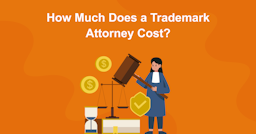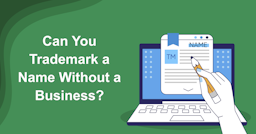Trady
22 April 2024 • 6 min read

Protecting your intellectual property is vital in a world where ideas and creativity drive progress.
This article delves into the nuances of trademarking — an essential facet of intellectual property law that safeguards your brand's unique symbols, names, and slogans.
We'll explain how trademarks differ from patents, explore the various types of intellectual property, and outline the specific requirements and steps necessary to secure a trademark.
Additionally, we'll discuss strategies to prevent trademark infringement and shed light on the concept of trade secrets.
Whether you're a budding entrepreneur or an established business, understanding how to trademark your idea effectively is important to maintain your competitive edge and brand identity.
Join us as we guide you through the process, ensuring your innovations are well-protected.
Understanding the distinction between trademarks and patents is crucial for effectively protecting your intellectual assets.
According to trademark law, a trademark is primarily concerned with safeguarding brand identifiers such as logos, slogans, and names that distinguish goods or services.
In contrast, a patent protects inventions or discoveries.
It grants the inventor exclusive rights to sell, use, or make the invention for a certain period.
This section explores the fundamental differences between these two forms of intellectual property, helping you choose the right protection for your ideas and innovations.
Intellectual property (IP) refers to creations of the mind for which exclusive rights are recognized.
Under the intellectual property law, owners are granted exclusive rights to various intangible assets.
Here are three other types of intellectual property other than trademarks:
Trademarking an idea involves several specific requirements that must be met to successfully register a trademark.
Here are the essential requirements:
Need more information? Read our article: "What to Expect When Applying for a Trademark: A Comprehensive Guide."
To trademark an idea, which in reality means trademarking a brand identifier like a name, logo, or slogan associated with that idea, you'll need to follow several essential steps.
Here is a clear outline of the trademark registration process:
Learn more about our trademark search engine in the below video:
To effectively prevent trademark infringement, it's essential to conduct a thorough search to ensure your trademark doesn't infringe on existing marks.
Registering your trademark provides legal protection and the exclusive right to use the trademark in connection with the goods or services listed.
As a trademark owner, use the ® symbol to communicate your rights and deter potential infringers.
Regularly monitoring the market is vital to identifying unauthorized uses early.
Educating employees, customers, and the public about your trademark can prevent unintentional infringements.
If you do find a potential infringement, a cease and desist letter can often resolve the issue initially. However, if the infringement continues, legal action may be necessary.
Maintaining the strength of your trademark through consistent use and legal enforcement actions is crucial.
Also, keep your registration up to date by filing all necessary renewals and declarations of use in a timely manner.
By implementing these measures, you can effectively safeguard your trademark and maintain brand integrity.
In conclusion, trademarking is a powerful tool for protecting your brand and securing your market position.
Understanding the different types of intellectual property, meeting the specific requirements for trademarks, and following the correct procedures can effectively safeguard your creative assets.
Remember, trademark protection is an investment in your brand's future. It helps prevent infringement and maintain your unique identity in a competitive landscape.
With Trademarkia, you can streamline the process and ensure that your ideas remain exclusively yours.
Stay informed, stay protected, and keep innovating — your brand's integrity depends on it.
The cost to trademark an idea varies depending on the country and method of filing but generally includes government filing fees and possibly attorney fees. In the United States, for example, the filing fees can range from $225 to $600 per class of goods or services.
Intellectual property protection for an idea often involves a combination of intellectual property rights, such as patents for inventions, copyrights for original works, or trademarks for brand identifiers. Securing a nondisclosure agreement (NDA) before sharing your idea with others can also offer legal protection.
Trademarks protect brand identifiers like names, logos, and slogans, not abstract ideas. To trademark a brand identifier, you must file an application with the appropriate government body, such as the U.S. Patent and Trademark Office, demonstrating its use in commerce.
Trademarking an idea for free is not typically possible as there are inherent costs associated with filing a trademark application. However, you can reduce costs by researching and filing the application yourself instead of hiring an attorney. Some jurisdictions may offer reduced fees for low-income applicants.
A trademark can last indefinitely, provided it is continually used in commerce and renewed on time. In the U.S., trademarks must be renewed every ten years, along with submitting a declaration of continued use to the Trademark Office.
AUTHOR
Introducing Trady, the charming AI personality and resident "Creative Owl" authoring the Trademarkia blog with a flair for the intellectual and the whimsical. Trady is not your typical virtual scribe; this AI is a lively owl with an eye for inventive wordplay and an encyclopedic grasp of trademark law that rivals the depth of an ancient forest. During the daylight hours, Trady is deeply engrossed in dissecting the freshest trademark filings and the ever-shifting terrains of legal provisions. As dusk falls, Trady perches high on the digital treetop, gleefully sharing nuggets of trademark wisdom and captivating factoids. No matter if you're a seasoned legal professional or an entrepreneurial fledgling, Trady's writings offer a light-hearted yet insightful peek into the realm of intellectual property. Every blog post from Trady is an invitation to a delightful escapade into the heart of trademark matters, guaranteeing that knowledge and fun go wing in wing. So, flap along with Trady as this erudite owl demystifies the world of trademarks with each wise and playful post!
Related Blogs

How Much Does a Trademark Attorney Cost?...
07 May 2024 • 6 min read

Is Filing a Trademark Hard? (+ How to Ma...
03 May 2024 • 7 min read

What Is the Most Common Reason That a Tr...
03 May 2024 • 6 min read

Can You Trademark a Name Without a Busin...
03 May 2024 • 7 min read

Is a Trademark Worth It for a Small Busi...
30 April 2024 • 7 min read